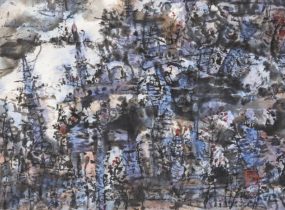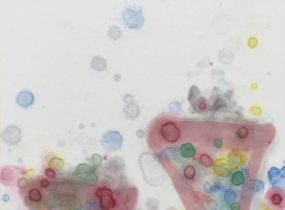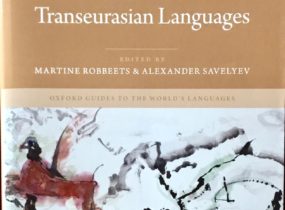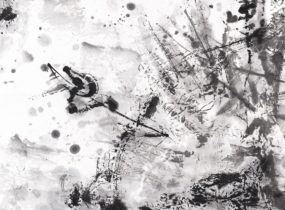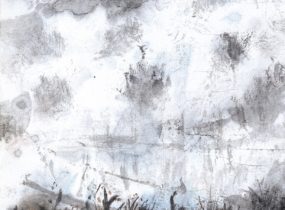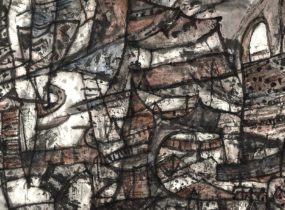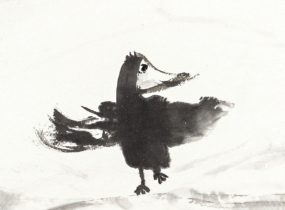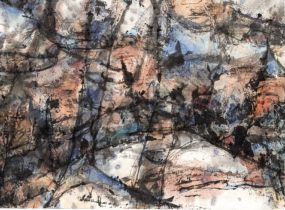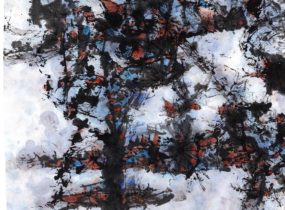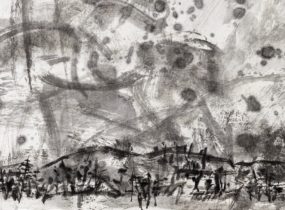My encounter with him has affected not only my art, but also my character
I was born in Tokushima City and started learning watercolor painting from Mr. Hiroshi Sano at the age of three. He was a distinguished teacher especially in terms of teaching children – thus I was able to experience the pleasure of painting with artistic freedom and was given the insight to the richness of color. This childhood experience, an important process for children’s growing up, helped me build a strong confidence in my art.
After high school, I took Aesthetic and Art courses at Doushisha University in Kyoto where I studied oil painting under Mr. Shinjo Saito, currently Head Priest of Shinsho Gokuraku-ji Temple in Kyoto. Apart from anything else, he taught me the importance of going along with courage to break the limit of established styles. My encounter with him has affected not only my art, but also my character.
important turning point for me.
Shortly afterwards, I faced a period when I did not produce any pieces of work due to the overlap of matters such as the trip to Beijing University for research that was required for writing a dissertation on Chinese pottery, my husband’s relocation, pregnancy and birth and parenting. During this time, however, my passion for painting did not die. But when I thought about the risk that my daughter may put the oil paint into her mouth, I was not able to unscrew the paint tubes. It was then that I happened to meet Mr. Ma Xinghua, a Chinese ink painter living in Fukuoka City, and I took this opportunity to start studying ink painting. Since my college days I had gained interest in traditional Chinese culture and art, so I was very fortunate to have been able to study under Mr. Ma, who started a new era in Chinese ink painting. Even now, he teaches me various theories and techniques concerning ink painting. Until then, I had only been familiar with western methods of expression and space composition, so I can say that this encounter with ink painting – an art that has established its theories and techniques over a long period of history – was an important turning point for me.
Therefore it is not rare for me to leave the abstract pieces as they are when I can not come up with specific images.
For instance when I paint, I start my strokes with the feeling or idea that I get on the spur of the moment without giving it a thought as to what it would end up like. At times I frolic with the water, the ink, and the paper whereas at other times I struggle against them. The results of these are lines, shapes and tones whose existence cannot be denied, and the artist has no other choice but to accept them. Unlike working on a canvas, it is impossible to scrape off mistakes or to white them out. However, because ink painting requires only natural materials such as water, ink, brush and paper, it often contains unexpected and unforeseen coincidences that make up effects which can never be intentionally repeated. This sometimes makes me feel as though somebody is cooperating with me when I paint, even though I am on my own, and I think that this is the element that makes ink painting differ greatly from that of oil. I recognize this composition of marks and lines that are the result of these coincidences as a picture and accept it as an artistic piece. Therefore it is not rare for me to leave the abstract pieces as they are when I can not come up with specific images.
This, I can say, is the charm and pleasure of ink paintings.
Another difference between ink painting and western painting is the logic concerning blank spaces. In western painting, the existence of blank spaces indicate unfinished work, whereas in ink painting, blank space not only helps the black of the ink stand out well, but gives people freedom for imagination when they see the painting. For these reasons it is important that a reasonable amount of the paper is left blank. In other words, the work depends on how much the artist has not painted. This leads to a paradoxical world of “leave blank, paint the blank”. I may be the one who leaves the spaces open, but it is the people who see the painting who fill it in – painting their emotions. I think that the important thing is not how much of my emotions I thrust out onto the paper, but that my work may become a cue to let the people who see it feel it in their own way according to their experiences and sensibilities. This can happen because of the effect the materials make; not just in my work, but in all ink paintings. The blots and faded brush strokes of the ink, various hues, or even just the creative blank spaces on their own have the force to touch people’s soul and stir their feelings. This, I can say, is the charm and pleasure of ink paintings.
I feel a strong sense of appreciation for being able to have this experience.
I have enjoyed painting since a young age and have managed to come this far. The question of whether I have improved since then is debatable. However, now as I look back I can say that I have been supported and saved by painting especially through the influence of ink painting. It is easy to miss the beauty that coincidences make if you plan ahead when painting because thoughts can restrict the art. And when at times I happened to plan ahead, the painting resulted in an unnatural wreck. On the other hand, I was able to encounter a new insight of myself when I succeeded in painting freely as an innocent child does. I was able to experience a refreshing feeling as if I were taken through a journey on the sea of ink on a ship that sets sail every time I pick up the brush. What captured me most were the unexpected discoveries and surprises that awaited me there that even I could not foresee. I feel a strong sense of appreciation for being able to have this experience.

